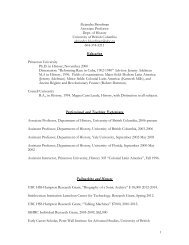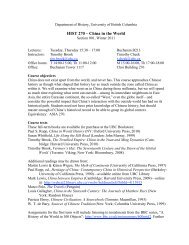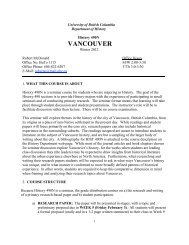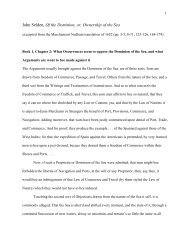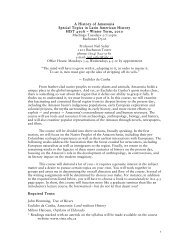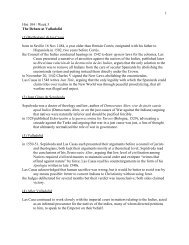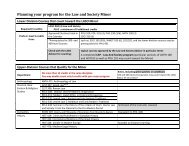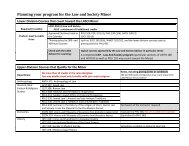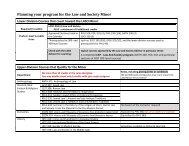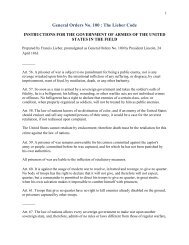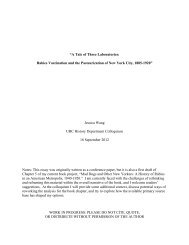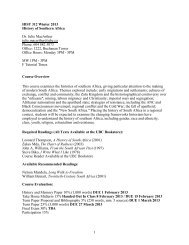Orientalizing the Pacific Rim: - History, Department of
Orientalizing the Pacific Rim: - History, Department of
Orientalizing the Pacific Rim: - History, Department of
Create successful ePaper yourself
Turn your PDF publications into a flip-book with our unique Google optimized e-Paper software.
In an attempt to dispel <strong>the</strong> illusion that <strong>the</strong>re was a ‘yellow peril’ in <strong>the</strong> United<br />
States and that Asians were “unassimilable,” <strong>the</strong> Reverend Sidney Gulick had included<br />
in his book The American Japanese Problem chapters answering ‘Yes’ to questions such<br />
as “Are Japanese Assimilable?” and “Can Americans Assimilate Japanese?” Examples<br />
<strong>of</strong> <strong>the</strong> ‘assimilability’ <strong>of</strong> <strong>the</strong> Japanese centered around ‘Americanized’ Japanese<br />
children in Christian homes and schools in America, complete with pictures <strong>of</strong> <strong>the</strong>m in<br />
American dress and hair-styles. Proudly, one <strong>of</strong> <strong>the</strong> picture captions announced that<br />
<strong>the</strong> “American-Japanese” man in <strong>the</strong> photograph could “speak no Japanese” and was<br />
a graduate <strong>of</strong> Yale--obvious pro<strong>of</strong> that he had reached <strong>the</strong> pinnacle <strong>of</strong> ‘white, anglosaxon,<br />
Protestant’ achievement in America. 21 Even <strong>the</strong> reference to ‘American<br />
Japanese’ ra<strong>the</strong>r than Japanese American was a calculated attempt at emphasizing <strong>the</strong><br />
‘American’ ra<strong>the</strong>r than ‘Japanese’ nature <strong>of</strong> <strong>the</strong> young man.<br />
Outward signs such as clothing and hair style became <strong>the</strong> pro<strong>of</strong> <strong>of</strong> outright<br />
assimilation, since <strong>the</strong>y signified <strong>the</strong> ‘loss’ <strong>of</strong> traditional dress and speech. Gulick and<br />
o<strong>the</strong>r pro-Japanese writers <strong>of</strong>ten used <strong>the</strong>se signs as a rhetorical weapon to combat <strong>the</strong><br />
fears <strong>of</strong> anything less than ‘100% Americanism’ which <strong>the</strong> nativist organizations were<br />
propagating. 22 Americanization was a focal term in <strong>the</strong> debate which surrounded <strong>the</strong><br />
image <strong>of</strong> America as a ‘melting pot,’ and as we shall see, <strong>the</strong> question <strong>of</strong> ‘assimilation’<br />
became <strong>the</strong> center <strong>of</strong> <strong>the</strong> ‘Oriental problem.’ For <strong>the</strong> missionaries, a key claim for <strong>the</strong>ir<br />
argument against nativist groups such as <strong>the</strong> American Legion and <strong>the</strong> Sons <strong>of</strong> <strong>the</strong><br />
Golden West was that ‘Orientals’ were in fact ‘assimilable’ to American life, as proven<br />
21 Gulick, The American Japanese Problem, cited above, 220.<br />
22 The best study <strong>of</strong> 19th-Century American nativism remains John Higham, Strangers<br />
in <strong>the</strong> Land: Patterns <strong>of</strong> American Nativism, 1860-1925 (New Brunswick: Rutgers<br />
University Press, 1955)<br />
16



